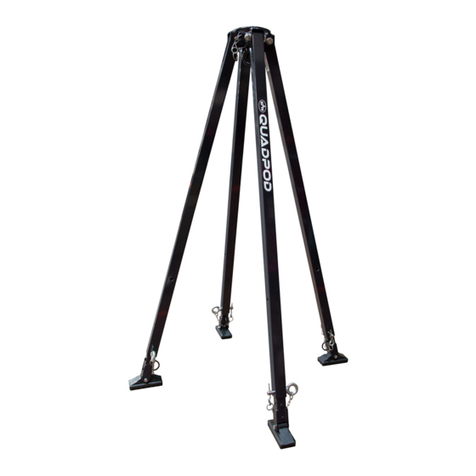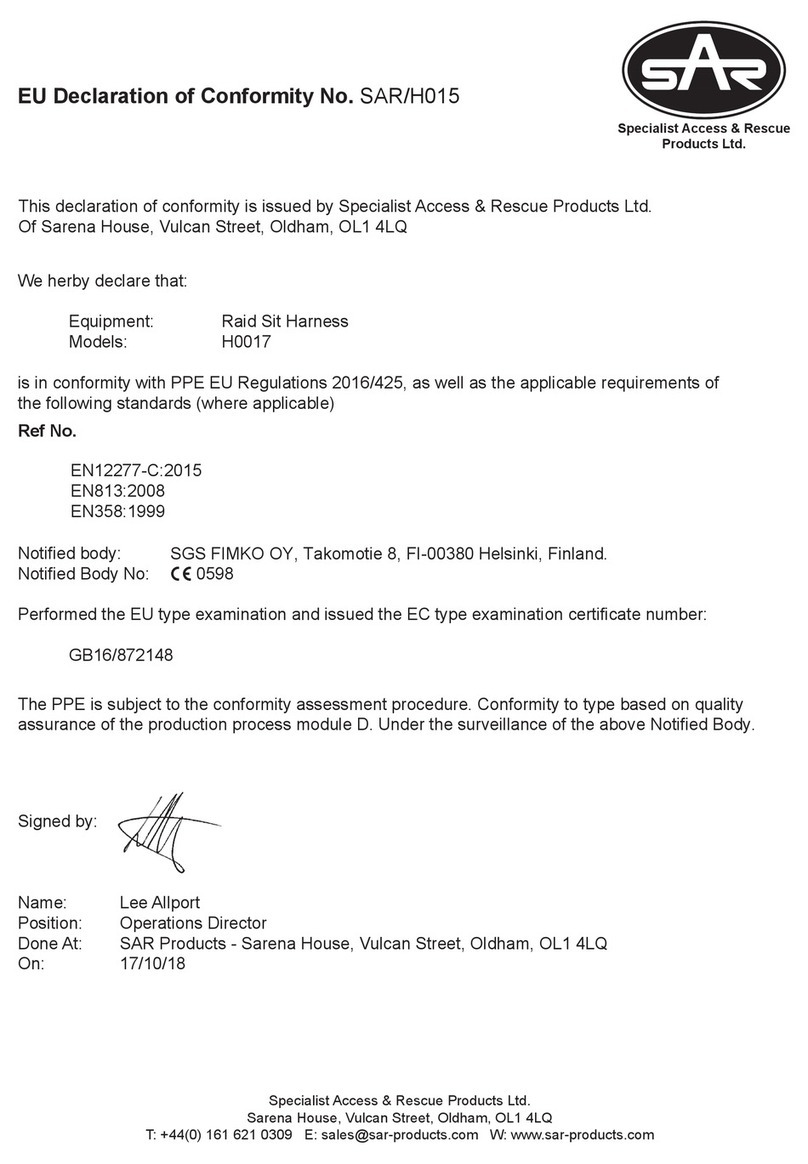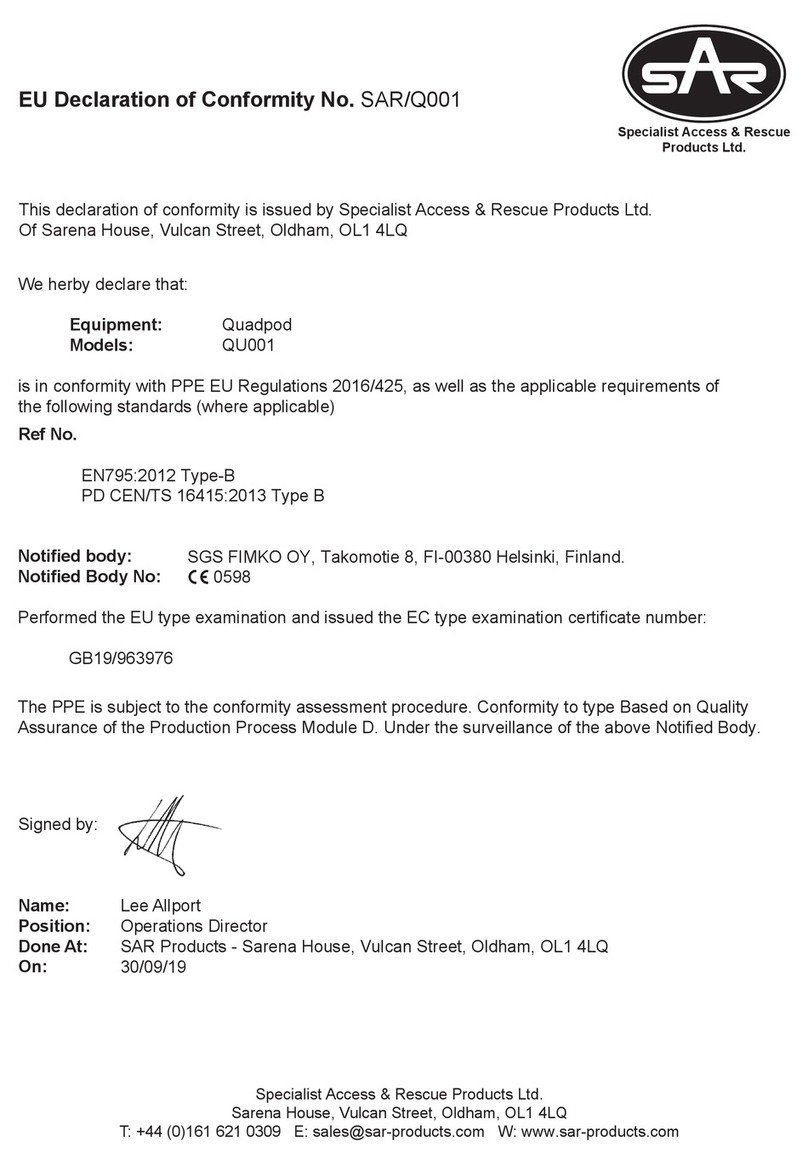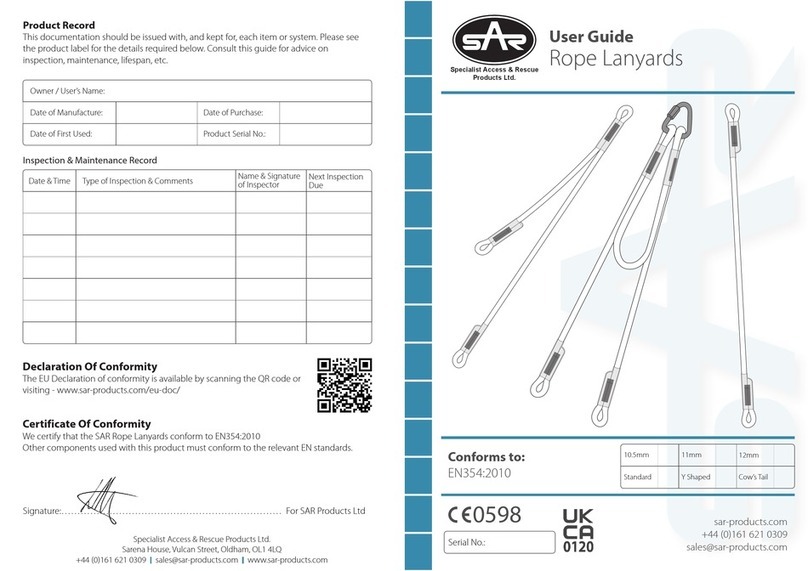
Warning: Make sure you have read and understood these
instructions before using the equipment.
User
It is advisable that each item of personal protection
equipment is issued to each user for his or her own use. The
user should satisfy himself/herself that he/she does not suffer
from any medical condition which could effect his/her own
safety whilst using this equipment normally and in a rescue
situation
Inspection
It is the responsibility of the user to carry out a visual
inspection of every part of the equipment prior to use. If you
are in any doubt, withdraw the equipment and return it to
your supervisor. The equipment should be thoroughly
inspected by a competent person (other than the user) at
intervals not greater than 6 months. This period should be
reduced if the equipment is heavily used.
Read the inspection check list:
Webbing, Stitching & Rope: Check all webbing & rope -
there should be no evidence of cuts, fraying or burning. Each
stitch pattern should be examined - there must be no broken
stitches or cuts, each stitch pattern must be intact.
UV Degradation: Avoid leaving the lanyard in direct sunlight.
Evidence of UV degradation is shown by fading or powdering
of the webbing or rope.
Chemical Attack: Avoid all contact with chemicals. Oil, grease
and paint are harmless. Generally if it harms the skin it will
harm the equipment. Evidence of chemical attack is shown by
discolouration or powdering of the webbing or rope.
Metal Fittings: All the metal fittings should be free from
excessive wear, rust or deformation. There should be no sharp
edges.
The Lanyard Should Be Taken Out Of Use If It Shows Any
Signs Of Signicant Abrasion, UV Degradation, Rust Or
Excessive Wear.
Product Markings
All markings on the equipment should be clear and legible.
Training
This piece of equipment should only be used by a person who
has been trained and is fully competent in the use of personal
protective equipment, or used under the direct supervision of
such a person.
Anchorage Points
Only use anchorage points that have been specially designed
and approved by your supervisor. Anchorage points should be
located above the user where possible and must have a
minimum strength of 16kn. The user should carry out work in
such a way that will minimise both the potential for falls and
the fall distance.
Rescue Plan
The user should ensure that an effective rescue plan to deal
with any emergency is in place prior to use.
Connecting For Fall Arrest
This lanyard should be connected to the approved fall arrest
attachment point of the full body harness as follows:-
1) Only connect the free end of the energy absorber (label
end) to the harness attachment point.
2) Always use the shortest possible twin-legged energy
absorbing lanyard suitable for the task.
3) This lanyard is fitted with an energy absorber that in the
event of a fall will increase the length of the lanyard by 1.75
meters. I.e. A standard 1.5 meter lanyard will increase 3.25
meters when deployed. The user should ensure that the
space into which the user will fall is free from hazards and
that there is sufficient clearance to avoid a collision with the
ground.
4) The user should always position the energy absorbing
lanyard as high as possible and also minimise the amount of
slack in the lanyard.
5) Only use connectors provided with the lanyard or ones that
have been approved to BS EN 362.
6) Always make sure that all connectors and safety hooks
are correctly locked shut.
7) Never wrap the lanyard around a structure and fasten the
connector/hook back onto the textile part of the lanyard.
Compatibility
This lanyard must only be used in conjunction with other
pieces of personal protective equipment that have been
manufactured to the relevant British Standard i.e. BS EN 361,
362, 363, 795.
The user should make sure that any connected item does not
interfere with the integrity of any other connected item.
Use:
This Lanyard has been designed and manufactured in
accordance with British Standard BS EN 8513:2009 Personal fall
protection - Twin-legged energy absorbing lanyards -
Specification
This Lanyard can be used as follows:-
(A) As part of an assembly to protect the user in a fall from a
height.
(B) The two legged lanyard configuration enables permanent
attachment to an anchorage point whilst the user is
transferring positions. The lanyard will be supplied with the
second of the two legs secured to the first leg. When you wish
to move position then simply undo the velcro strap to deploy
the second leg and attach the second leg to a new anchorage
point before disconnecting the first leg. Once a new work
position has been achieved it is recommended that the
second leg is folded and secured to the first leg to avoid
creating a trip hazard.
Do not attach the unused leg back on to your clothing
or harness as this will render the lanyard inoperable and
will prove fatal.
In the event of the user falling from a height, the intended
purpose of this Lanyard is to arrest the fall of the user and to
dissipate the kinetic energy developed during the fall.
When used to protect the user in the event of a fall from a
height, this lanyard must be used in conjunction with a Full
Body Harness manufactured to BS EN 361.
This equipment should not be used for any other purpose,
other than, that for which it has been designed.
This SAR twin lanyard and Shock Absorber is manufactured
from 100% polyester webbing and thread, 100% nylon rope,
aluminium ring and aluminium or steel connectors.
Lifespan
It is difficult to give an exact lifespan for this Lanyard as this
depends on how the product is used. The working life can
vary between a single use in extreme conditions (e.g. highly
chemical environment) to a maximum of 10 years from
manufacture. The working life will be reduced through age,
general wear and tear, abrasion, cuts, prolonged exposure to
UV light including sunlight, elevated temperature (max 50
degrees C) and exposure to chemicals.
Cleaning
Wash in warm clean water using a mild detergent, rinse
thoroughly and allow to dry naturally away from an open fire
or other sources of direct heat.
Storage & Transportation
The equipment should be properly stored and transported (in
the polythene bag supplied) to prevent any contact with
sharp objects or harmful substances. The equipment should
be stored in an area, which is dry and free from direct sunlight.
This piece of equipment should not be altered or added to
without the prior written consent of SAR Products Ltd. Any
repair should be carried out in accordance with the
manufactures written instructions. Should this piece of
equipment be re-sold outside the original country of
destination, then the re-seller shall provide instructions for use,
maintenance, periodic examination and for repair in the
language of the country in which the equipment is to be
re-sold.
Meanings Of Markings
• The name, trademark or any other means of identification
provided by the manufacturer or supplier.
• The batch or serial number
• The year of manufacture
• CE… EC logo followed by the number of the notified body
• EN… European standard attributed to this PPE
• Product description and/or reference
• Evaluation of capacity in kN
Strengths quoted are when the product is tested new and are
in accordance with the manufacturer’s test methods or to the
appropriate standard. Any weights and measurements are
approximate.
Nothing in this document affects the consumer’s statutory
rights.
Notied body
SGS FIMKO OY, Takomotie 8, FI-00380 Helsinki, Finland.
Notified Body No: 0598
Fitting
1) Fit end A of the lanyard to the approved attachment point
on the safety harness (see harness ‘Instructions for Use’to
verify this point).
2) Fit end B of the lanyard to the anchorage point.
3) Ensure that all connectors are correctly locked shut.
4) Ensure that the anchorage point where ever possible is
always above the user and that the ‘slack’ in the lanyard is
kept to a minimum.
5) The connector may be attached to the alloy ring.
6) Never wrap the lanyard around a structure and fasten the
connector back onto the lanyard.
7) On reaching your working destination both legs of this
lanyard should be attached to the same anchorage point.
Never attach the spare leg back onto part of your
equipment e.g. your harness or belt or clothing. This will
prevent the energy absorber from deploying and prove
fatal.
8) This Lanyard is fitted with a shock absorber that when
deployed will increase the length of the Lanyard from 1.5m
to 3.25m with 130kg weight. The user should always ensure
that the space into which the user falls is sufficient and free
from hazards. This distance will vary depending on where
the anchorage point is and the height of the user. As a
guide this distance will be 2.5 meters (if the anchorage
point is at its highest point) to 5.75 meters (if the anchorage
point is at its lowest point).
9) The maximum total length (before deployment) of the
lanyard including the connectors is 1.5 meters.
Do not extend the length of the lanyard by adding other
items. This will cause the lanyard to be inoperable and
will be fatal.
10) This lanyard should not be used for any other purpose
than fall arrest.
End A
End B
Energy Absorber
Aluminium
Ring
3.25m
When
Deployed
1.5m
Lanyard


























